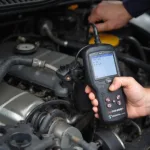OBD2 emissions codes, also known as diagnostic trouble codes (DTCs), are an essential part of your vehicle’s onboard diagnostic system. These codes provide valuable insights into the health of your emission control system and can help pinpoint potential problems before they become major headaches. This article will delve deep into the world of OBD2 emissions codes, covering everything from understanding their structure to troubleshooting common issues.
Decoding OBD2 Emissions Codes: Structure and Meaning
OBD2 emissions codes follow a standardized five-character alphanumeric structure. Each character provides specific information about the nature of the fault. Understanding this structure is crucial for effective diagnosis and repair. The first character indicates the system where the fault lies (e.g., “P” for Powertrain, “B” for Body, “C” for Chassis, and “U” for Network). The second character specifies the code type, whether it’s a generic OBD2 code (0) or a manufacturer-specific code (1). The third character identifies the specific subsystem affected, such as fuel, air, or ignition. The final two characters pinpoint the exact nature of the fault within that subsystem. For instance, P0420 signifies a Catalyst System Efficiency Below Threshold (Bank 1).
Common OBD2 Emissions Codes and Their Causes
Numerous OBD2 emissions codes exist, each signifying a different problem. Some of the most frequently encountered codes include P0420 (Catalyst System Efficiency Below Threshold), P0171 (System Too Lean Bank 1), P0172 (System Too Rich Bank 1), and P0300 (Random/Multiple Cylinder Misfire Detected). These codes can stem from a variety of issues, ranging from faulty oxygen sensors and catalytic converters to vacuum leaks and fuel delivery problems.
Understanding the underlying causes of these codes is paramount for accurate diagnosis. For example, P0420 may indicate a failing catalytic converter, but it could also be caused by a faulty oxygen sensor. Similarly, P0171 and P0172, while pointing towards fuel mixture issues, can be triggered by anything from a malfunctioning mass airflow sensor (MAF) to a vacuum leak.
Troubleshooting OBD2 Emissions Codes: A Step-by-Step Guide
Diagnosing and fixing the issues indicated by OBD2 emissions codes involves a systematic approach. First, retrieve the codes using an OBD2 scanner. Then, research the specific code and its potential causes. Next, visually inspect related components for any obvious damage or wear. After the visual inspection, use diagnostic tools and procedures to pinpoint the faulty component. This may include checking fuel pressure, testing oxygen sensors, or monitoring live data streams.
Finally, once the faulty component is identified, repair or replace it as needed. Always clear the codes after the repair and retest the system to ensure the problem is resolved. Remember, a thorough diagnosis is critical for avoiding unnecessary repairs and ensuring long-term vehicle health. Ignoring OBD2 emissions codes can lead to more significant problems and even vehicle failure.
Why are OBD2 Emissions Codes Important?
OBD2 emissions codes are vital for several reasons. They help ensure your vehicle complies with environmental regulations by monitoring the effectiveness of the emissions control system. They can also prevent costly repairs by allowing you to address minor issues before they escalate. Moreover, understanding these codes empowers you to make informed decisions about your vehicle’s maintenance and repair.
Conclusion: Mastering OBD2 Emissions Codes for a Healthier Vehicle
Mastering the art of interpreting and troubleshooting obd2 emissions codes is essential for every car owner. It empowers you to take proactive steps towards maintaining your vehicle’s health, ensuring compliance with environmental standards, and preventing costly repairs. By understanding the meaning behind these codes, you can make informed decisions about your car’s maintenance and ensure it runs smoothly for years to come.
FAQ
-
What does an OBD2 emissions code mean? It indicates a problem with your vehicle’s emission control system.
-
How do I check my OBD2 emissions codes? Use an OBD2 scanner.
-
Can I fix OBD2 emissions codes myself? Some issues are simple fixes, others require professional help.
-
What is the most common OBD2 emissions code? P0420 (Catalyst System Efficiency Below Threshold).
-
What happens if I ignore OBD2 emissions codes? Potential for further damage and failed emissions tests.
-
Do all OBD2 codes relate to emissions? No, there are other types of codes for various systems.
-
How do I clear OBD2 emissions codes? Using an OBD2 scanner, or sometimes by disconnecting the battery.
For further assistance, please contact us via WhatsApp: +1(641)206-8880, Email: [email protected] or visit our office at 789 Elm Street, San Francisco, CA 94102, USA. We have a 24/7 customer support team ready to assist you.


